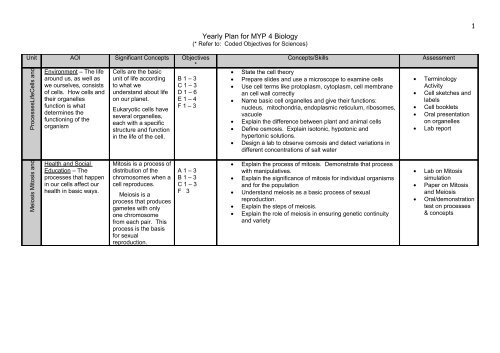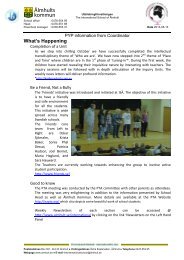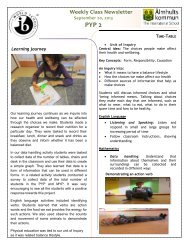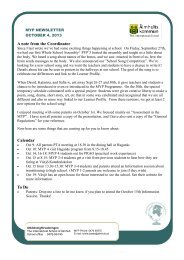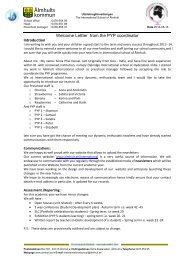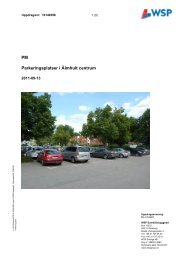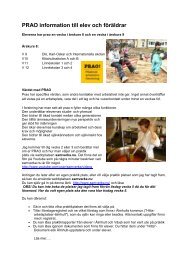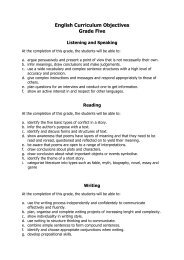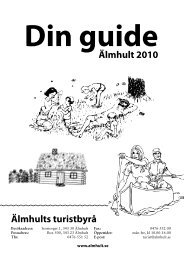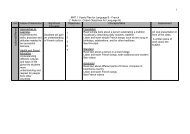Yearly Plan for MYP 1 Science
Yearly Plan for MYP 1 Science
Yearly Plan for MYP 1 Science
Create successful ePaper yourself
Turn your PDF publications into a flip-book with our unique Google optimized e-Paper software.
<strong>Yearly</strong> <strong>Plan</strong> <strong>for</strong> <strong>MYP</strong> 4 Biology<br />
(* Refer to: Coded Objectives <strong>for</strong> <strong>Science</strong>s)<br />
1<br />
Unit AOI Significant Concepts Objectives<br />
*<br />
Environment – The life Cells are the basic<br />
around us, as well as unit of life according B 1 – 3<br />
we ourselves, consists to what we<br />
C 1 – 3<br />
of cells. How cells and understand about life D 1 – 6<br />
their organelles on our planet. E 1 – 4<br />
function is what<br />
F 1 – 3<br />
Eukaryotic cells have<br />
determines the<br />
several organelles,<br />
functioning of the<br />
each with a specific<br />
organism<br />
structure and function<br />
in the life of the cell.<br />
Cells and<br />
ProcessesLife<br />
Concepts/Skills<br />
• State the cell theory<br />
• Prepare slides and use a microscope to examine cells<br />
• Use cell terms like protoplasm, cytoplasm, cell membrane<br />
an cell wall correctly<br />
• Name basic cell organelles and give their functions:<br />
nucleus, mitochondria, endoplasmic reticulum, ribosomes,<br />
vacuole<br />
• Explain the difference between plant and animal cells<br />
• Define osmosis. Explain isotonic, hypotonic and<br />
hypertonic solutions.<br />
• Design a lab to observe osmosis and detect variations in<br />
different concentrations of salt water<br />
Assessment<br />
• Terminology<br />
Activity<br />
• Cell sketches and<br />
labels<br />
• Cell booklets<br />
• Oral presentation<br />
on organelles<br />
• Lab report<br />
Meiosis Mitosis and<br />
Health and Social<br />
Education – The<br />
processes that happen<br />
in our cells affect our<br />
health in basic ways.<br />
Mitosis is a process of<br />
distribution of the<br />
chromosomes when a<br />
cell reproduces.<br />
Meiosis is a<br />
process that produces<br />
gametes with only<br />
one chromosome<br />
from each pair. This<br />
process is the basis<br />
<strong>for</strong> sexual<br />
reproduction.<br />
A 1 – 3<br />
B 1 – 3<br />
C 1 – 3<br />
F 3<br />
• Explain the process of mitosis. Demonstrate that process<br />
with manipulatives.<br />
• Explain the significance of mitosis <strong>for</strong> individual organisms<br />
and <strong>for</strong> the population<br />
• Understand meiosis as a basic process of sexual<br />
reproduction.<br />
• Explain the steps of meiosis.<br />
• Explain the role of meiosis in ensuring genetic continuity<br />
and variety<br />
• Lab on Mitosis<br />
simulation<br />
• Paper on Mitosis<br />
and Meiosis<br />
• Oral/demonstration<br />
test on processes<br />
& concepts
<strong>Yearly</strong> <strong>Plan</strong> <strong>for</strong> <strong>MYP</strong> 4 Biology<br />
(* Refer to: Coded Objectives <strong>for</strong> <strong>Science</strong>s)<br />
2<br />
Unit AOI Significant Concepts Objectives<br />
*<br />
Health & Social Nucleic acids contain<br />
Education –<br />
the genetic code <strong>for</strong> A 1 – 3<br />
understanding what all known organisms. B 1 – 3<br />
DNA is<br />
C 1 – 3<br />
- understanding how<br />
F 3<br />
DNA is passed from The arrangement of<br />
one generation to the the bases in DNA and<br />
next<br />
RNA are the code <strong>for</strong><br />
- understanding more the production of<br />
about issues such as proteins.<br />
cloning and stem cell<br />
research because of<br />
our understanding of<br />
DNA<br />
- understanding about<br />
the uniqueness of each<br />
organism’s DNA and<br />
its use in identification<br />
of individuals and<br />
relatives<br />
- beginning to<br />
understand the<br />
concept of genetically<br />
transmitted traits and<br />
diseases<br />
Acids Nucleic<br />
Concepts/Skills<br />
• Define nucleic acid and name the two common nucleic<br />
acids<br />
• Give a brief account of the history of the discovery of<br />
DNA’s structure<br />
• Describe the structure of DNA<br />
• Name the DNA bases and how they pair<br />
• Illustrate the “unzipping” of a DNA and the replication of<br />
the single DNA strands into a double strand<br />
• Relate replication to mitosis<br />
• Describe mRNA and tRNA<br />
• Explain and simulate the unzipping of DNA and the<br />
<strong>for</strong>mation of mRNA<br />
• Explain and simulate the role of tRNA bringing amino acids<br />
to the mRNA<br />
• Explain and simulate the steps in the full process of protein<br />
synthesis<br />
• Explain the significance of protein synthesis and how it<br />
relates to genetics<br />
Assessment<br />
• Class discussion –<br />
participation and<br />
contribution<br />
• DNA simulation lab<br />
& display<br />
• Lab on DNA<br />
Extraction<br />
• Protein Synthesis<br />
simulation lab,<br />
display &<br />
explanation


